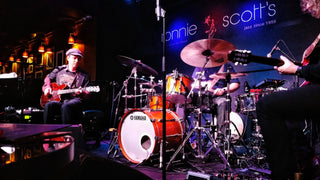Kurt Rosenwinkel and Bandit 65, Ronnie Scott’s, London — power chords and body-shaking grooves Two guitarists and a drummer conjured compelling jazz improvisations Mike Hobart JANUARY 18, 2018
The closely worked textures and supple rhythms that infused this intriguing gig were conjured on the fly from two guitars, a drum kit and a battery of pedals and effects. Each piece opened with a wash of electronica and evolved into a body-shaking groove, cued by a just-invented riff or a repeated beat. But though even the core of this multi-layered gig was left to chance, it had the clean lines and sense of order of pre-composed music. The band released their first recording in 2014 and have been together ever since.
At this gig — a stopover between Japan and France — the musicians projected a road-tested rapport that suited their moniker Bandit 65, the name of a trusty guitar amp. The evening opened with guitarists Kurt Rosenwinkel and Tim Motzer juxtaposing whiny melodies over wheezy synthesised sounds. Drummer Gintas Janusonis added a hiss of cymbals and pistol-shot triggers; textures thickened, lines came at speed and then the first groove arrived, a steady Latin funk with Rosenwinkel in full cry over Motzer’s strummed bass. As the piece evolved, power chords crunched, there was a wail of rocking blues accompanied by the thump of mallets, and a swish of brushes supporting the picked outlines of a country ballad. The second improvisation opened with a synthesised chuckle, oscillated into a mist of white noise and settled into grainy urban funk. The third began with a thrum of atonal chords and lyrical pan-pipe effects; it faded over head-nodding hip-hop and twisted and turned in between.
Rosenwinkel and Motzer were so in tune with each other’s strums, lines and sonic effects that at times it was hard to tell them apart. But for the most part, roles were clearly defined, though frequently swapped, and Motzer’s steel-stringed acoustic was a warm contrast to Rosenwinkel’s jazzier, more metallic lines. The abstract beginnings had purpose, and with Janusonis setting the pulse and providing propulsive support, the grooves had bite.
The second set proceeded as the first. Each of the three pieces hovered in time, then firmed into a house-shaking rhythm. But with soundscapes varying and grooves referencing different roots, each improvisation was distinct. The band built the evening to a tense, rhythm-infused high, faded over sparse electronic beeps and then Rosenwinkel spoke. “That’s our time,” he said. All too soon, the performance was done. ★★★★☆

